Good morning! I love camping, but sometimes it can be hard to pick the perfect camping spot to live in for the week or weekend. It is especially hard to pick the perfect spot as you are driving around the campground repeatedly, pulling the rv. To help make it easier to pick the perfect camping spot, we have a few guidelines and a camping notebook that we use.
The camping notebook was a Christmas present from the husband. We keep it handy in the truck all the time. During the winter months, when it is too snowy and cold to camp, we drive through different campgrounds and record the cost and sites that we like. It is fun to discuss and choose spots we would like or not like. During the rest of the year, if we are near a new campground we will drive through and record its details also. I make sure to write the year down, since prices have changed drastically since we have started camping about 28 years ago.
Depending on the day of the week, the busy-ness of the campground and the weather, we don’t always get to choose the spot we like. But it is handy to have the notebook with the information, especially at a new campground, so we are not just circling the campground repeatedly.
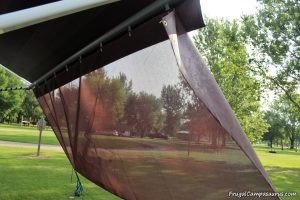
If we travel to a new campground that we don’t have information on, we try to check online maps to help us find 3-4 good spots before we go. We have 3 main guidelines that we use to help pick our perfect camping spot: street lights, afternoon shade and trees, and to a lesser degree bathrooms, water hydrants, playgrounds and trails.
When we are picking a camping spot, we particularly watch for streetlights. I think streetlights should be a good thing; they light the way for walking to the bathrooms in the middle of the night, they may keep animals away and they make a great nightlight. They could even help you park the rv if you arrive late. But we watch for streetlights to avoid them. We camped at a nice, secluded spot, off in a corner of the campground once. Just once. Now we avoid the spot. It has a big streetlight, which we didn’t really notice, when we set up. That evening, we lit a fire. It was like having a campfire during the day: the streetlight lit up the whole camping spot.
Now, we watch for streetlights and even lights on buildings, like the bathrooms. Often, the bathroom building will have a light by the door which stays on all night. That is great if you are headed there in the middle of the night, but not great if the awning and campfire side of the camper faces the light.
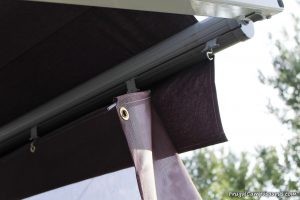
Having afternoon shade in a camping spot is another guideline we consider. The direction the camper faces can really influence the interior temperature of the camper. We try to park so the awning and door side of the camper does not have afternoon sun. This is the side of the camper where most people have chairs, picnic tables, rugs and the campfire. It is the porch or living area for the camp spot. It is not as enjoyable if the living area is in full, hot, afternoon sun, especially in the heat of the summer. Having shade, from a tree, can help the air conditioner work less and keep the rv cooler. Even having the awning open, shading the side of the camper, will have the same effect.
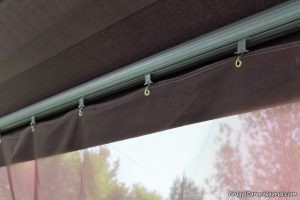
Sometimes, we just can’t find a spot with nice tree shade. Often, the spots are facing the wrong direction. Several years ago, we bought a sun screen that slides into the awning roller. We thought it would be nice to have options to make our own shade, instead of squinting into the sun as we sit outside. It is a great idea, but we haven’t used it very much. The piping, on the sun screen, slides into the awning tube, but it is very difficult to slide through the opening and across the length of the awning, so we didn’t use it very often.
This year, the husband modified the awning. It is so much easier to install, I think we will use it a lot more now. The husband actually cut holes in the sunscreen and installed grommets, so we can hang it from the same hooks that we hang the awning lights. No more tugging and yanking it along the length of the awning! The grommets ended up being easy to install. We thought this was the only time we would use grommets, but buying the cheapest grommet kit was still probably not the best idea. It worked, but the husband ended up cutting an x for a hole with an exacto knife, instead of using the punch provided in the kit. It also didn’t bend the grommets right when the husband pounded them together. They will hold, but if we need to install grommets on something else, we will get a different kit.
Trees around the camping spot is our last main guideline that we watch for. The trees can help with the shade and inside temperature of the rv. Trees can also be a hazard. Low hanging branches can scrape and tear a rubber roof. If the trees are close to the parking spot, when slides are extended, they can hit the tree. The husband has a helpful hint to tell how far the slides will extend before they are extended. It is easier to move the camper before unhooking, if the rv is too close to the tree for the slides to go all the way out. We have seen plenty of slides just barely missing a tree.
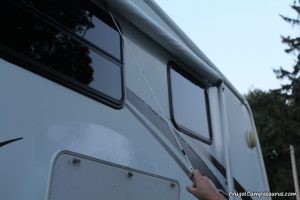
The husband measured the width the slide extends out, with the rod that is used to pull down the awning. Then, he marked the amount with tape. Now, when he wonders if he is far enough away to extend the slides, he just uses the rod to measure, before he unhooks the truck or extends the slides.
There are a few other, smaller guidelines we think about when choosing a camping spot.
Bathrooms: We like to avoid the bathroom traffic, especially at night, which usually involves banging of the bathroom doors. It is also nice to leave the close spots for tenters and pop-up campers, who may need to be close to the bathrooms.
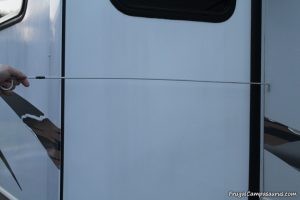
Water hydrants: We don’t need to be right next to a water hydrant, but it is nice to be close enough to stretch a hose or two to the hydrant if we run low on water.
Playgrounds: When the kids were little, it was nice to be close to the playground. We would set our lawn chairs so that we could watch the kids from the camping spot. Now, we try to leave those spots for the parents with little children. It is also much quieter away from the playground.
Trail heads: Depending on the size of the camping spot, we try to watch for trail heads. If the spots are close together, where hikers need to cross near the camper to get to a trail, I would rather get a different spot. Some camping spots are spacious, especially when there is a trail head or path to fishing spot nearby.
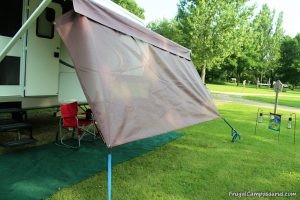
During our last minute, Fourth of July, camping weekend, we did pretty well with most of our guidelines. We picked a spot that was far away from streetlights, so it was nice and dark for the campfire. There were nice shade trees, with plenty of room for the slides. The camper faced away from the afternoon sun, which was great since it was over 90 degrees outside. We even used the new and improved sun screen to help shade the camper so the air conditioner didn’t need to work so hard.
We had just filled the water tank, and the bathrooms and playground were on the other side of the campground. But we had forgotten about the trail heads. Thankfully, the spots were spacious, because there was a horse trail head beyond the edge of site. It was fine, and the riders were friendly, but the first time one went through to the trail- it startled me. I just wish I had been aware it was there. Later, we walked on the trail and discovered raspberries, gooseberries and mulberries- what a fun trail.
I hope this helps you to find the perfect camping spot. We have been using these guidelines for many years. We have even been using them lately at our favorite state park. As it gets busier and harder to get our favorite spots, we use the guidelines to find new camping spots that we like.
Happy Camping (or finding the perfect camping spot!)
Frugal Campasaurus
